brake sensor JEEP GRAND CHEROKEE 2011 Owner handbook (in English)
[x] Cancel search | Manufacturer: JEEP, Model Year: 2011, Model line: GRAND CHEROKEE, Model: JEEP GRAND CHEROKEE 2011Pages: 350, PDF Size: 4.58 MB
Page 127 of 350
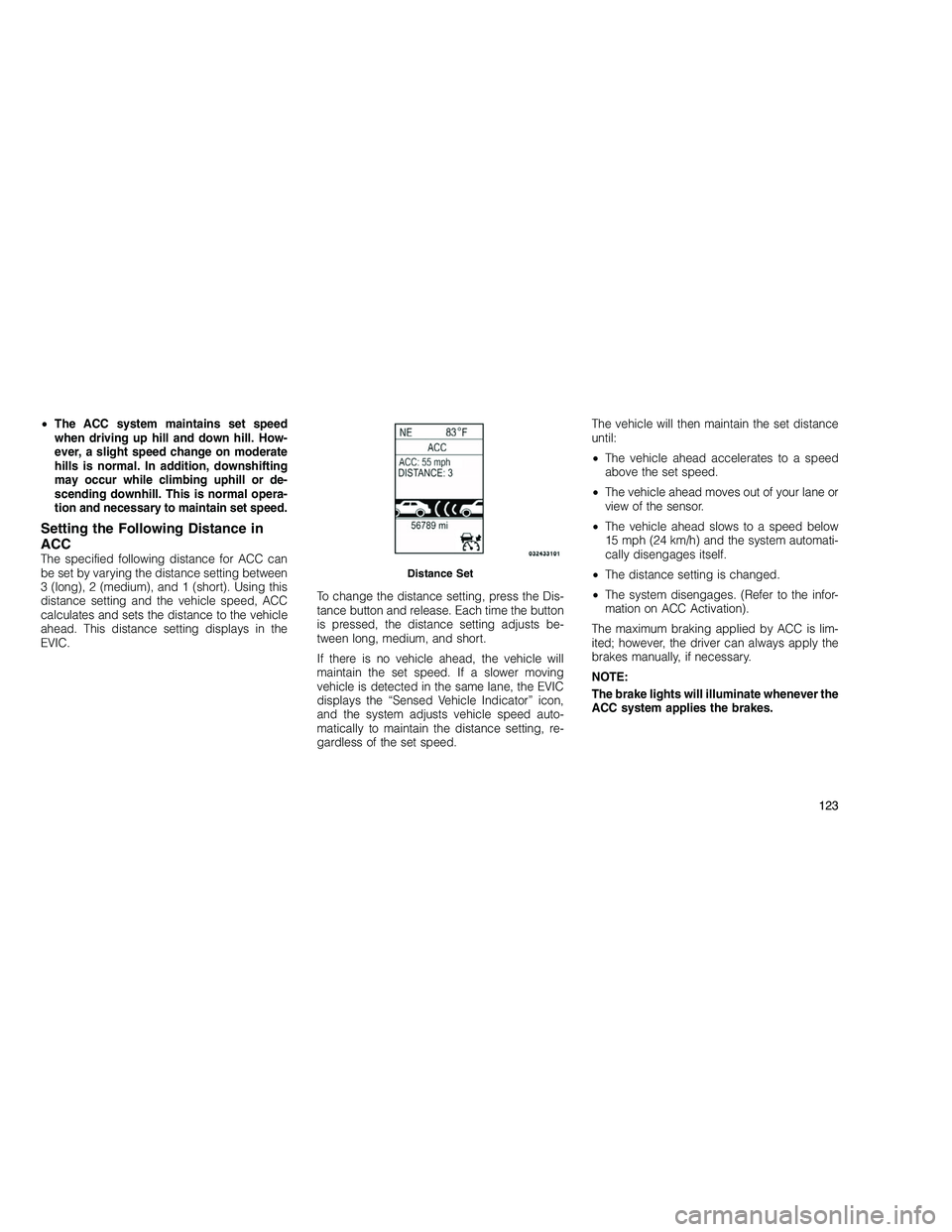
•The ACC system maintains set speed
when driving up hill and down hill. How-
ever, a slight speed change on moderate
hills is normal. In addition, downshifting
may occur while climbing uphill or de-
scending downhill. This is normal opera-
tion and necessary to maintain set speed.
Setting the Following Distance in
ACC
The specified following distance for ACC can
be set by varying the distance setting between
3 (long), 2 (medium), and 1 (short). Using this
distance setting and the vehicle speed, ACC
calculates and sets the distance to the vehicle
ahead. This distance setting displays in the
EVIC. To change the distance setting, press the Dis-
tance button and release. Each time the button
is pressed, the distance setting adjusts be-
tween long, medium, and short.
If there is no vehicle ahead, the vehicle will
maintain the set speed. If a slower moving
vehicle is detected in the same lane, the EVIC
displays the “Sensed Vehicle Indicator” icon,
and the system adjusts vehicle speed auto-
matically to maintain the distance setting, re-
gardless of the set speed.The vehicle will then maintain the set distance
until:
•
The vehicle ahead accelerates to a speed
above the set speed.
• The vehicle ahead moves out of your lane or
view of the sensor.
• The vehicle ahead slows to a speed below
15 mph (24 km/h) and the system automati-
cally disengages itself.
• The distance setting is changed.
• The system disengages. (Refer to the infor-
mation on ACC Activation).
The maximum braking applied by ACC is lim-
ited; however, the driver can always apply the
brakes manually, if necessary.
NOTE:
The brake lights will illuminate whenever the
ACC system applies the brakes.Distance Set
123
Page 134 of 350
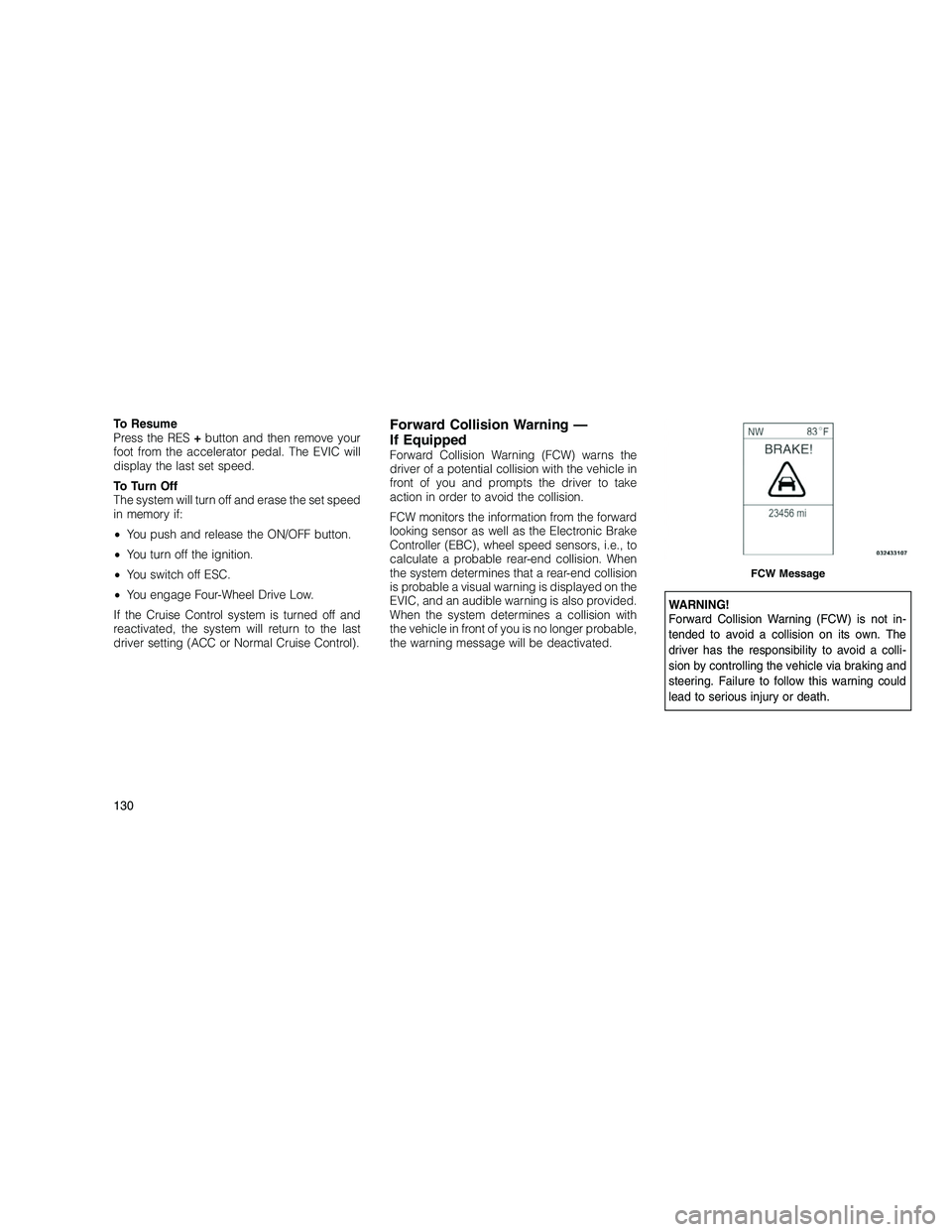
To Resume
Press the RES+button and then remove your
foot from the accelerator pedal. The EVIC will
display the last set speed.
To Turn Off
The system will turn off and erase the set speed
in memory if:
• You push and release the ON/OFF button.
• You turn off the ignition.
• You switch off ESC.
• You engage Four-Wheel Drive Low.
If the Cruise Control system is turned off and
reactivated, the system will return to the last
driver setting (ACC or Normal Cruise Control).Forward Collision Warning —
If Equipped
Forward Collision Warning (FCW) warns the
driver of a potential collision with the vehicle in
front of you and prompts the driver to take
action in order to avoid the collision.
FCW monitors the information from the forward
looking sensor as well as the Electronic Brake
Controller (EBC), wheel speed sensors, i.e., to
calculate a probable rear-end collision. When
the system determines that a rear-end collision
is probable a visual warning is displayed on the
EVIC, and an audible warning is also provided.
When the system determines a collision with
the vehicle in front of you is no longer probable,
the warning message will be deactivated.
WARNING!
Forward Collision Warning (FCW) is not in-
tended to avoid a collision on its own. The
driver has the responsibility to avoid a colli-
sion by controlling the vehicle via braking and
steering. Failure to follow this warning could
lead to serious injury or death.
FCW Message
130
Page 169 of 350
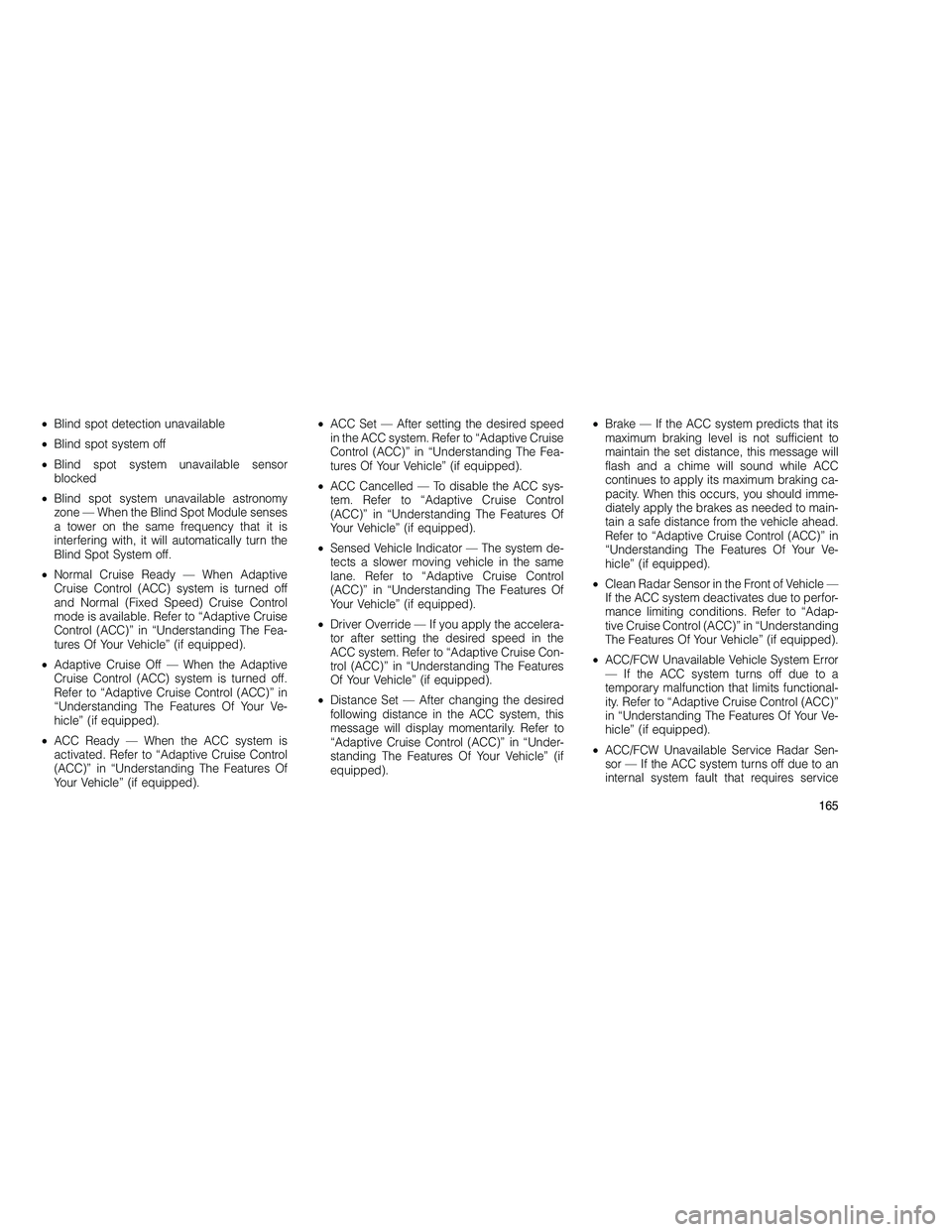
•Blind spot detection unavailable
• Blind spot system off
• Blind spot system unavailable sensor
blocked
• Blind spot system unavailable astronomy
zone — When the Blind Spot Module senses
a tower on the same frequency that it is
interfering with, it will automatically turn the
Blind Spot System off.
• Normal Cruise Ready — When Adaptive
Cruise Control (ACC) system is turned off
and Normal (Fixed Speed) Cruise Control
mode is available. Refer to “Adaptive Cruise
Control (ACC)” in “Understanding The Fea-
tures Of Your Vehicle” (if equipped).
• Adaptive Cruise Off — When the Adaptive
Cruise Control (ACC) system is turned off.
Refer to “Adaptive Cruise Control (ACC)” in
“Understanding The Features Of Your Ve-
hicle” (if equipped).
• ACC Ready — When the ACC system is
activated. Refer to “Adaptive Cruise Control
(ACC)” in “Understanding The Features Of
Your Vehicle” (if equipped). •
ACC Set — After setting the desired speed
in the ACC system. Refer to “Adaptive Cruise
Control (ACC)” in “Understanding The Fea-
tures Of Your Vehicle” (if equipped).
• ACC Cancelled — To disable the ACC sys-
tem. Refer to “Adaptive Cruise Control
(ACC)” in “Understanding The Features Of
Your Vehicle” (if equipped).
• Sensed Vehicle Indicator — The system de-
tects a slower moving vehicle in the same
lane. Refer to “Adaptive Cruise Control
(ACC)” in “Understanding The Features Of
Your Vehicle” (if equipped).
• Driver Override — If you apply the accelera-
tor after setting the desired speed in the
ACC system. Refer to “Adaptive Cruise Con-
trol (ACC)” in “Understanding The Features
Of Your Vehicle” (if equipped).
• Distance Set — After changing the desired
following distance in the ACC system, this
message will display momentarily. Refer to
“Adaptive Cruise Control (ACC)” in “Under-
standing The Features Of Your Vehicle” (if
equipped). •
Brake — If the ACC system predicts that its
maximum braking level is not sufficient to
maintain the set distance, this message will
flash and a chime will sound while ACC
continues to apply its maximum braking ca-
pacity. When this occurs, you should imme-
diately apply the brakes as needed to main-
tain a safe distance from the vehicle ahead.
Refer to “Adaptive Cruise Control (ACC)” in
“Understanding The Features Of Your Ve-
hicle” (if equipped).
• Clean Radar Sensor in the Front of Vehicle —
If the ACC system deactivates due to perfor-
mance limiting conditions. Refer to “Adap-
tive Cruise Control (ACC)” in “Understanding
The Features Of Your Vehicle” (if equipped).
• ACC/FCW Unavailable Vehicle System Error
— If the ACC system turns off due to a
temporary malfunction that limits functional-
ity. Refer to “Adaptive Cruise Control (ACC)”
in “Understanding The Features Of Your Ve-
hicle” (if equipped).
• ACC/FCW Unavailable Service Radar Sen-
sor — If the ACC system turns off due to an
internal system fault that requires service
165
Page 184 of 350
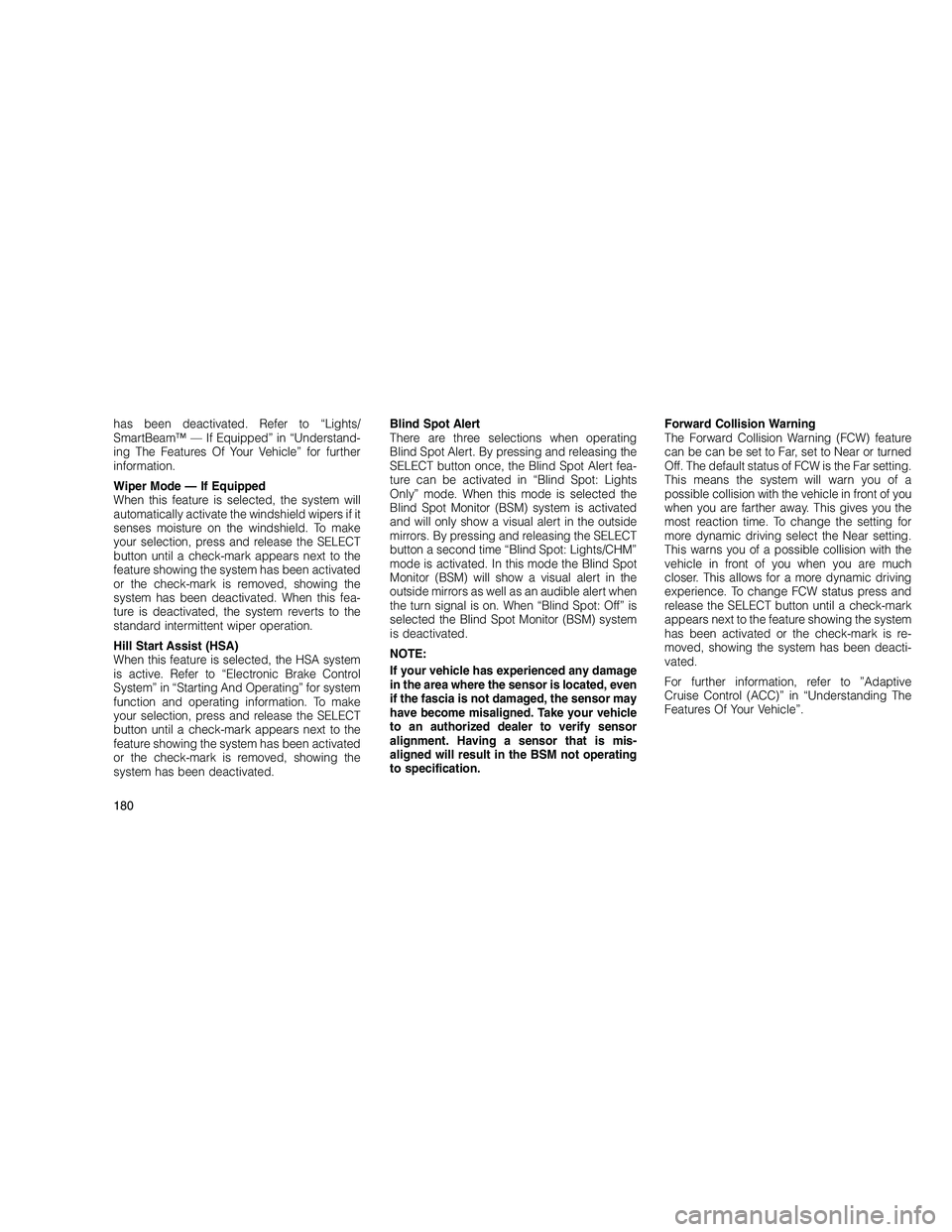
has been deactivated. Refer to “Lights/
SmartBeam™ — If Equipped” in “Understand-
ing The Features Of Your Vehicle” for further
information.
Wiper Mode — If Equipped
When this feature is selected, the system will
automatically activate the windshield wipers if it
senses moisture on the windshield. To make
your selection, press and release the SELECT
button until a check-mark appears next to the
feature showing the system has been activated
or the check-mark is removed, showing the
system has been deactivated. When this fea-
ture is deactivated, the system reverts to the
standard intermittent wiper operation.
Hill Start Assist (HSA)
When this feature is selected, the HSA system
is active. Refer to “Electronic Brake Control
System” in “Starting And Operating” for system
function and operating information. To make
your selection, press and release the SELECT
button until a check-mark appears next to the
feature showing the system has been activated
or the check-mark is removed, showing the
system has been deactivated.Blind Spot Alert
There are three selections when operating
Blind Spot Alert. By pressing and releasing the
SELECT button once, the Blind Spot Alert fea-
ture can be activated in “Blind Spot: Lights
Only” mode. When this mode is selected the
Blind Spot Monitor (BSM) system is activated
and will only show a visual alert in the outside
mirrors. By pressing and releasing the SELECT
button a second time “Blind Spot: Lights/CHM”
mode is activated. In this mode the Blind Spot
Monitor (BSM) will show a visual alert in the
outside mirrors as well as an audible alert when
the turn signal is on. When “Blind Spot: Off” is
selected the Blind Spot Monitor (BSM) system
is deactivated.
NOTE:
If your vehicle has experienced any damage
in the area where the sensor is located, even
if the fascia is not damaged, the sensor may
have become misaligned. Take your vehicle
to an authorized dealer to verify sensor
alignment. Having a sensor that is mis-
aligned will result in the BSM not operating
to specification.
Forward Collision Warning
The Forward Collision Warning (FCW) feature
can be can be set to Far, set to Near or turned
Off. The default status of FCW is the Far setting.
This means the system will warn you of a
possible collision with the vehicle in front of you
when you are farther away. This gives you the
most reaction time. To change the setting for
more dynamic driving select the Near setting.
This warns you of a possible collision with the
vehicle in front of you when you are much
closer. This allows for a more dynamic driving
experience. To change FCW status press and
release the SELECT button until a check-mark
appears next to the feature showing the system
has been activated or the check-mark is re-
moved, showing the system has been deacti-
vated.
For further information, refer to ”Adaptive
Cruise Control (ACC)” in “Understanding The
Features Of Your Vehicle”.
180
Page 229 of 350
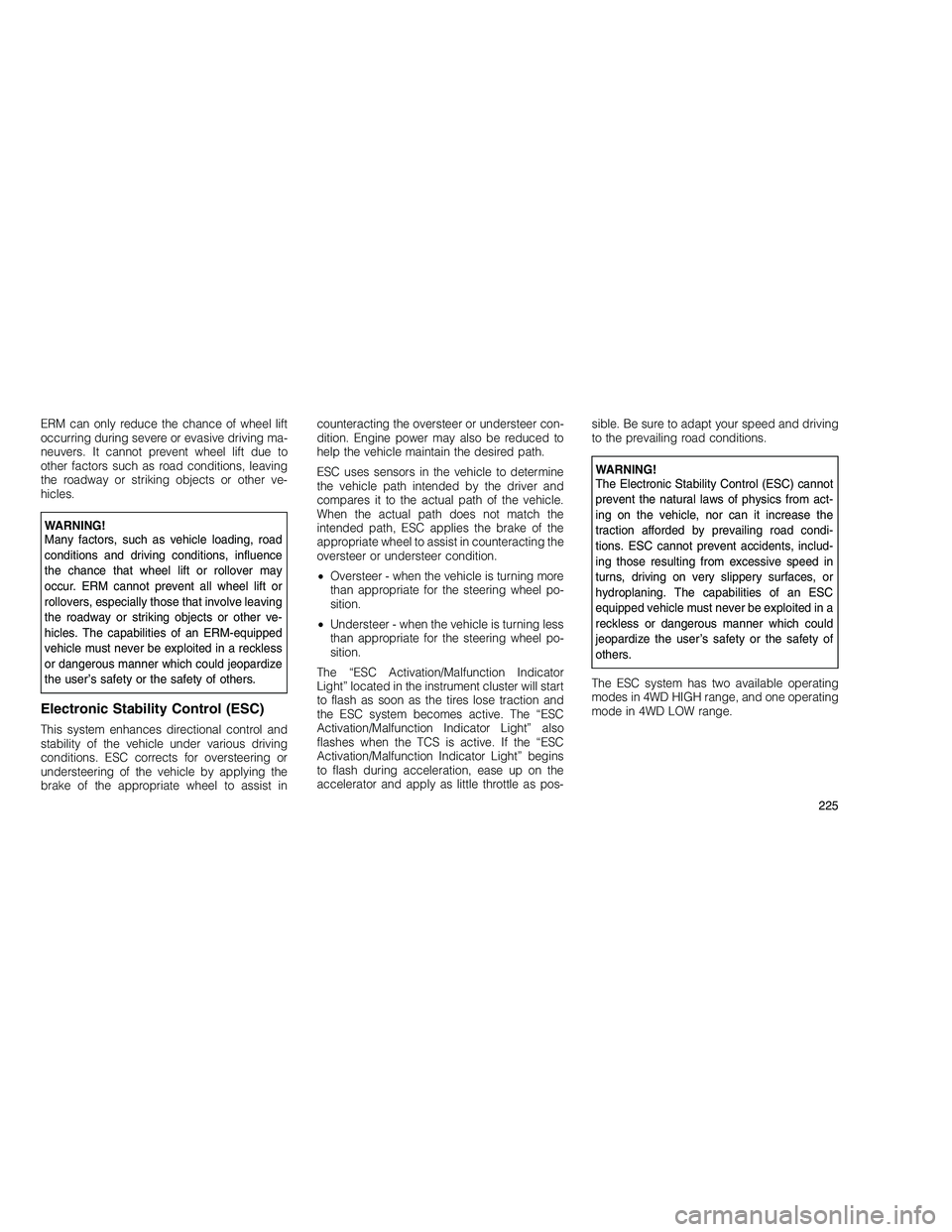
ERM can only reduce the chance of wheel lift
occurring during severe or evasive driving ma-
neuvers. It cannot prevent wheel lift due to
other factors such as road conditions, leaving
the roadway or striking objects or other ve-
hicles.
WARNING!
Many factors, such as vehicle loading, road
conditions and driving conditions, influence
the chance that wheel lift or rollover may
occur. ERM cannot prevent all wheel lift or
rollovers, especially those that involve leaving
the roadway or striking objects or other ve-
hicles. The capabilities of an ERM-equipped
vehicle must never be exploited in a reckless
or dangerous manner which could jeopardize
the user’s safety or the safety of others.
Electronic Stability Control (ESC)
This system enhances directional control and
stability of the vehicle under various driving
conditions. ESC corrects for oversteering or
understeering of the vehicle by applying the
brake of the appropriate wheel to assist incounteracting the oversteer or understeer con-
dition. Engine power may also be reduced to
help the vehicle maintain the desired path.
ESC uses sensors in the vehicle to determine
the vehicle path intended by the driver and
compares it to the actual path of the vehicle.
When the actual path does not match the
intended path, ESC applies the brake of the
appropriate wheel to assist in counteracting the
oversteer or understeer condition.
•
Oversteer - when the vehicle is turning more
than appropriate for the steering wheel po-
sition.
• Understeer - when the vehicle is turning less
than appropriate for the steering wheel po-
sition.
The “ESC Activation/Malfunction Indicator
Light” located in the instrument cluster will start
to flash as soon as the tires lose traction and
the ESC system becomes active. The “ESC
Activation/Malfunction Indicator Light” also
flashes when the TCS is active. If the “ESC
Activation/Malfunction Indicator Light” begins
to flash during acceleration, ease up on the
accelerator and apply as little throttle as pos- sible. Be sure to adapt your speed and driving
to the prevailing road conditions.
WARNING!
The Electronic Stability Control (ESC) cannot
prevent the natural laws of physics from act-
ing on the vehicle, nor can it increase the
traction afforded by prevailing road condi-
tions. ESC cannot prevent accidents, includ-
ing those resulting from excessive speed in
turns, driving on very slippery surfaces, or
hydroplaning. The capabilities of an ESC
equipped vehicle must never be exploited in a
reckless or dangerous manner which could
jeopardize the user’s safety or the safety of
others.
The ESC system has two available operating
modes in 4WD HIGH range, and one operating
mode in 4WD LOW range.
225
Page 230 of 350
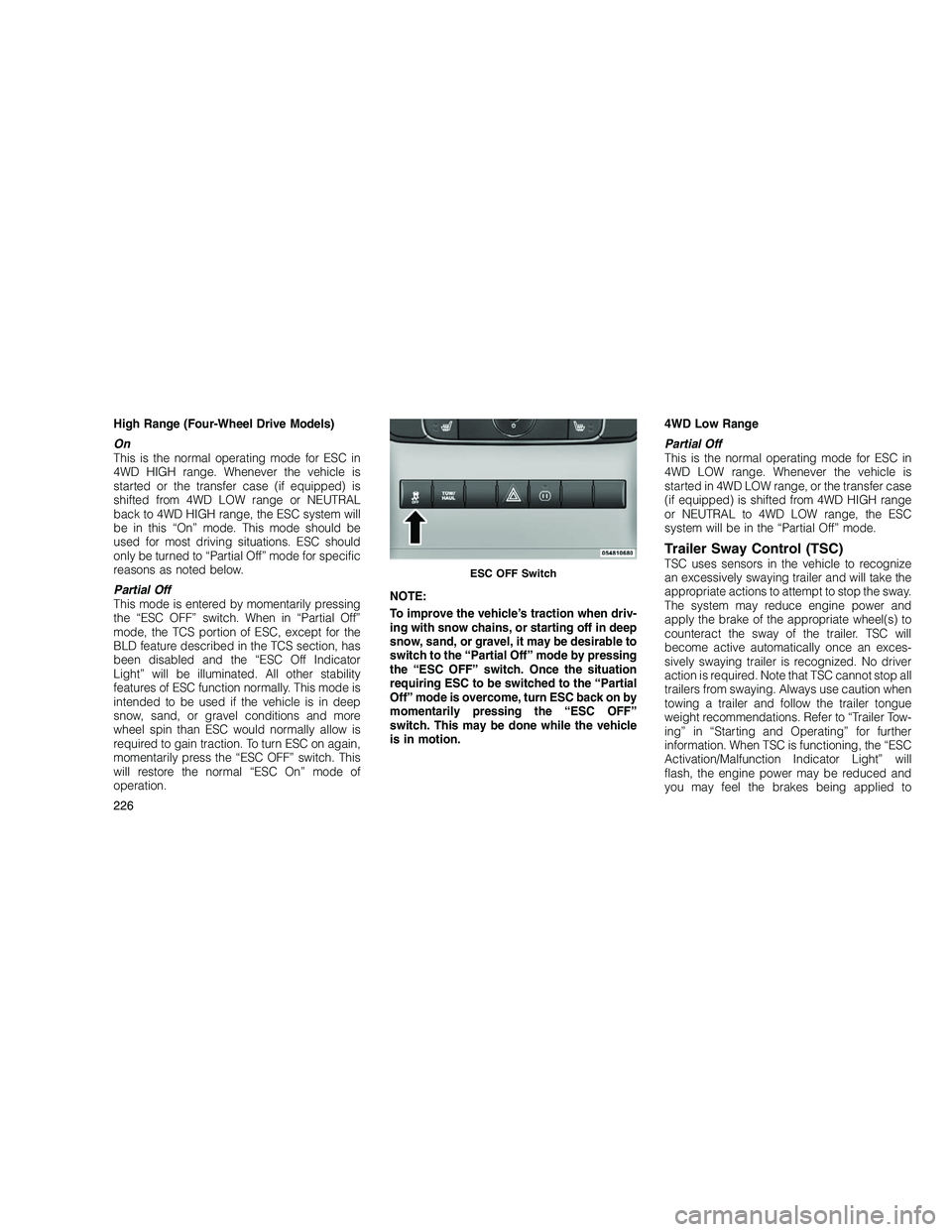
High Range (Four-Wheel Drive Models)
On
This is the normal operating mode for ESC in
4WD HIGH range. Whenever the vehicle is
started or the transfer case (if equipped) is
shifted from 4WD LOW range or NEUTRAL
back to 4WD HIGH range, the ESC system will
be in this “On” mode. This mode should be
used for most driving situations. ESC should
only be turned to “Partial Off” mode for specific
reasons as noted below.
Partial Off
This mode is entered by momentarily pressing
the “ESC OFF” switch. When in “Partial Off”
mode, the TCS portion of ESC, except for the
BLD feature described in the TCS section, has
been disabled and the “ESC Off Indicator
Light” will be illuminated. All other stability
features of ESC function normally. This mode is
intended to be used if the vehicle is in deep
snow, sand, or gravel conditions and more
wheel spin than ESC would normally allow is
required to gain traction. To turn ESC on again,
momentarily press the “ESC OFF” switch. This
will restore the normal “ESC On” mode of
operation.NOTE:
To improve the vehicle’s traction when driv-
ing with snow chains, or starting off in deep
snow, sand, or gravel, it may be desirable to
switch to the “Partial Off” mode by pressing
the “ESC OFF” switch. Once the situation
requiring ESC to be switched to the “Partial
Off” mode is overcome, turn ESC back on by
momentarily pressing the “ESC OFF”
switch. This may be done while the vehicle
is in motion.4WD Low Range
Partial Off
This is the normal operating mode for ESC in
4WD LOW range. Whenever the vehicle is
started in 4WD LOW range, or the transfer case
(if equipped) is shifted from 4WD HIGH range
or NEUTRAL to 4WD LOW range, the ESC
system will be in the “Partial Off” mode.
Trailer Sway Control (TSC)TSC uses sensors in the vehicle to recognize
an excessively swaying trailer and will take the
appropriate actions to attempt to stop the sway.
The system may reduce engine power and
apply the brake of the appropriate wheel(s) to
counteract the sway of the trailer. TSC will
become active automatically once an exces-
sively swaying trailer is recognized. No driver
action is required. Note that TSC cannot stop all
trailers from swaying. Always use caution when
towing a trailer and follow the trailer tongue
weight recommendations. Refer to “Trailer Tow-
ing” in “Starting and Operating” for further
information. When TSC is functioning, the “ESC
Activation/Malfunction Indicator Light” will
flash, the engine power may be reduced and
you may feel the brakes being applied toESC OFF Switch
226
Page 296 of 350
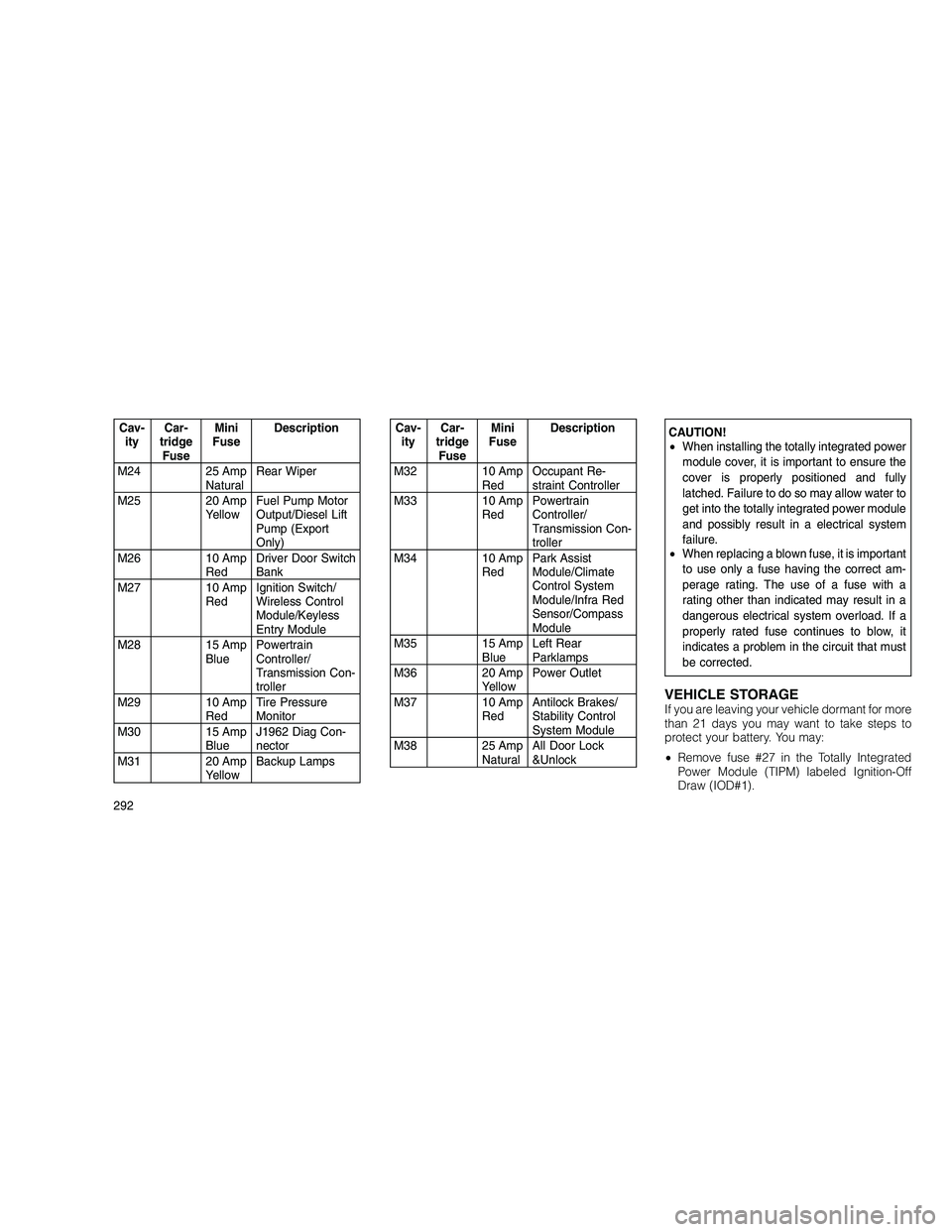
Cav-ity Car-
tridge Fuse Mini
Fuse Description
M24 25 Amp NaturalRear Wiper
M25 20 Amp YellowFuel Pump Motor
Output/Diesel Lift
Pump (Export
Only)
M26 10 Amp RedDriver Door Switch
Bank
M27 10 Amp RedIgnition Switch/
Wireless Control
Module/Keyless
Entry Module
M28 15 Amp BluePowertrain
Controller/
Transmission Con-
troller
M29 10 Amp RedTire Pressure
Monitor
M30 15 Amp BlueJ1962 Diag Con-
nector
M31 20 Amp YellowBackup LampsCav-
ity Car-
tridge Fuse Mini
Fuse Description
M32 10 Amp RedOccupant Re-
straint Controller
M33 10 Amp RedPowertrain
Controller/
Transmission Con-
troller
M34 10 Amp RedPark Assist
Module/Climate
Control System
Module/Infra Red
Sensor/Compass
Module
M35 15 Amp BlueLeft Rear
Parklamps
M36 20 Amp YellowPower Outlet
M37 10 Amp RedAntilock Brakes/
Stability Control
System Module
M38 25 Amp NaturalAll Door Lock
&UnlockCAUTION!
•
When installing the totally integrated power
module cover, it is important to ensure the
cover is properly positioned and fully
latched. Failure to do so may allow water to
get into the totally integrated power module
and possibly result in a electrical system
failure.
• When replacing a blown fuse, it is important
to use only a fuse having the correct am-
perage rating. The use of a fuse with a
rating other than indicated may result in a
dangerous electrical system overload. If a
properly rated fuse continues to blow, it
indicates a problem in the circuit that must
be corrected.
VEHICLE STORAGEIf you are leaving your vehicle dormant for more
than 21 days you may want to take steps to
protect your battery. You may:
• Remove fuse #27 in the Totally Integrated
Power Module (TIPM) labeled Ignition-Off
Draw (IOD#1).
292